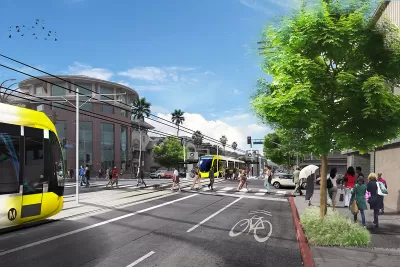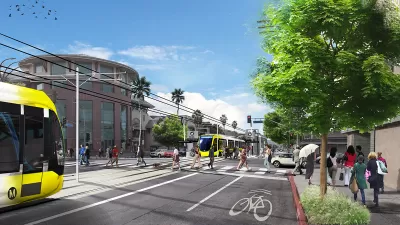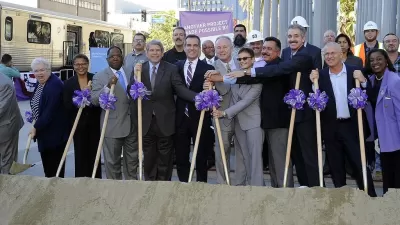The last time rail transit crossed L.A.'s San Fernando Valley was in the early 1950s.

The proposed East San Fernando Valley Light Rail Transit Project is making progress toward the estimated $2.8 billion to $3.6 billion needed for completion, according to an article by Steve Scauzillo published by the Los Angeles Daily News.
The Federal Transit Administration (FTA) announced $909 billion for the project early in May, then allocated an initial $100 million of that total a few weeks later. The funding was awarded through the FTA’s Expedited Project Delivery Pilot Program.
“The project’s 9.2-mile route will connect the LA Metro’s east-west G Line (Orange) at the Van Nuys Station with the Metrolink Station in Sylmar/San Fernando. The first phase will travel 6.7 miles along the center median of Van Nuys Boulevard to San Fernando Road. A second phase continues northwest another 2.5 miles along the Metrolink rail line,” writes Scauzillo.
“A total of 14 new stations are planned as are nine traction power substations, on overhead contact system, 34 vehicles and a maintenance and storage facility planned for Keswick Street. Once completed, it is estimated to carry 35,000 riders per day, according to LA Metro.”

The proposed project could eventually become the first rail transit project built completely in the San Fernando Valley since Pacific Red Cars stopped operating in 1952, according to Scauzillo. (The B Line, formerly the Red Line, has two stations located in the Valley. The Los Angeles County Metropolitan Transportation Authority's Board of Directors also approved a bus rapid transit route that would connect North Hollywood to Pasadena in the adjacent San Gabriel Valley earlier in March.)
The Metro Board of Directors approved the preferred alternative for the East San Fernando Valley Light Rail Transit Project in July 2018, and approved the environmental impact report for the project in December 2020.
FULL STORY: East San Fernando Valley rail line project gets $909 million boost from Feds

Trump Administration Could Effectively End Housing Voucher Program
Federal officials are eyeing major cuts to the Section 8 program that helps millions of low-income households pay rent.

Planetizen Federal Action Tracker
A weekly monitor of how Trump’s orders and actions are impacting planners and planning in America.

Ken Jennings Launches Transit Web Series
The Jeopardy champ wants you to ride public transit.

Washington Legislature Passes Rent Increase Cap
A bill that caps rent increases at 7 percent plus inflation is headed to the governor’s desk.

From Planning to Action: How LA County Is Rethinking Climate Resilience
Chief Sustainability Officer Rita Kampalath outlines the County’s shift from planning to implementation in its climate resilience efforts, emphasizing cross-departmental coordination, updated recovery strategies, and the need for flexible funding.

New Mexico Aging Department Commits to Helping Seniors Age ‘In Place’ and ‘Autonomously’ in New Draft Plan
As New Mexico’s population of seniors continues to grow, the state’s aging department is proposing expanded initiatives to help seniors maintain their autonomy while also supporting family caregivers.
Urban Design for Planners 1: Software Tools
This six-course series explores essential urban design concepts using open source software and equips planners with the tools they need to participate fully in the urban design process.
Planning for Universal Design
Learn the tools for implementing Universal Design in planning regulations.
Heyer Gruel & Associates PA
Ada County Highway District
Institute for Housing and Urban Development Studies (IHS)
City of Grandview
Harvard GSD Executive Education
Toledo-Lucas County Plan Commissions
Salt Lake City
NYU Wagner Graduate School of Public Service




























